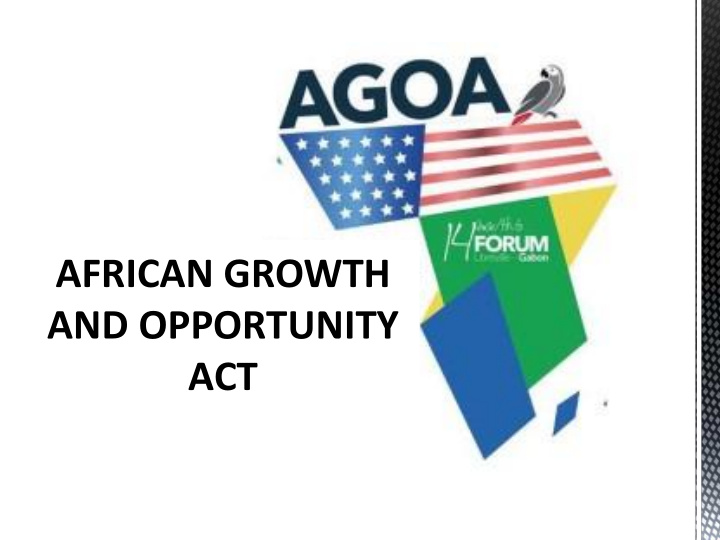



AFRICAN GROWTH AND OPPORTUNITY ACT
The Four Pillars of U.S. Policy in Africa Strengthen Democratic Institutions 1. Spur Economic Growth, Trade and Investment 2. Advance Peace and Security 3. Promote Opportunity and Development 4.
What is the African Growth and Opportunity Act? USG’s signature trade initiative with sub -Saharan Africa. Est. in May 2000, most recently reauthorized on June 2015, until 2025. Provides more liberal access to the U.S. market than any of our other unilateral trade preference arrangements. Reinforces African reform efforts, improves access to capacity building and technical expertise through regional Trade Hubs.
What Benefits Does AGOA Offer? Duty-free treatment to more than 6,400 products (with at least 35% African value-added): >1,800 tariff lines in addition to the standard 4,600 through the General System of Preferences (GSP). Under a Special Rule (“Third Country Fabric” provision), lesser - developed countries can enjoy an additional preference of duty-and quota-free access for apparel made from fabric of any origin .
AGOA Eligibility President conducts an annual determination of beneficiary countries’ adherence to eligibility criteria. AGOA-eligible countries have to have established, or be making continual progress toward establishing: 1) market-based economy; 2) rule of law, political pluralism, and right to due process; 3) elimination of barriers to U.S. trade and investment; 4) economic policies to reduce poverty; 5) a system to combat bribery and corruption; and 6) protection of internationally recognized worker rights Countries must also not engage in activities that undermine U.S. national security or foreign policy interests; and not engage in gross violations of internationally recognized human rights.
Congress Approves AGOA Renewal On June 25, 2015 the Senate approved legislation to re-authorize AGOA for ten years. President Obama signed the “Trade Preferences Enhancement Act of 2015” on June 29, 2015. Provides a 10 year extension of AGOA; Retains AGOA’s existing product coverage and includes third country fabric provision; Enhances and streamlines trade capacity building; Updates the eligibility criteria and review processes; Updates rules of origin to encourage regional cumulation.
Key Issues for AGOA Boosting AGOA utilization in the remaining ten years. Preparing for a more reciprocal U.S.-Africa trade and investment relationship. Ensuring Africa is not left behind as the rest of the world signs on to increasingly liberal “ plurilateral ” trade agreements.
2015 AGOA Snapshot $19 billion total exports ; $9.3 billion under AGOA + GSP Top beneficiaries: South Africa, Angola, Chad, Nigeria, Kenya, Lesotho AGOA including GSP provisions 2015 1% 5% 4% Agricultural products 16% Forest products Chemicals and related products Energy-related products 7% Textiles and apparel Footwear Minerals and metals 11% Machinery Transportation equipment 56% Electronic products Miscellaneous manufactures
2014 AGOA Exports from the Region Angola: $4.4 billion South Africa: $3.1 billion Lesotho: $289 million Malawi: $60 million Botswana: $9 million ($7.5 million in 2015) Mozambique: $9 million Zambia: $5 million Namibia: $0 Swaziland and Zimbabwe: Not Eligible
Key AGOA Eligible Products Apparel and footwear Jewelry Leather Certain motor vehicle components A variety of agricultural products Arts and crafts Chemicals and steel Full product list at http://agoa.info/about- agoa/products.html
Looking for a Specific Product? Visit the U.S. Harmonized Tariff Schedule at https://hts.usitc.gov/ The U.S. Trade Representative’s guide at http://trade.gov/agoa/eligibility/product-eligibility.asp
What Are the Challenges? Timeline requirements Large volume demand Quality standards Import procedure requirements International competition Finding a U.S. buyer
More AGOA Resources Exporter Toolkit Guide on doing business with the U.S. Export readiness assessment A guide for small foreign exporters Information of sanitary and phytosanitary measures Botswana Investment and Trade Center Botswana’s Embassy in Washington D.C. Botswana Government Strategies Private partners U.S. companies and associations Multinational companies Regional marketing companies
Trade Shows of Interest Heimtextil 10 – 13 January 2017: Messe Frankfurt, Germany Home and contract textiles Handcrafters Art and Craft Shows 18 – 19 March 2016: Northville, USA (three times per year) Handmade and decorative items, ceramics and pottery, clothing and textiles, photography, metal and wood products Baby World Riga 8-10 April 2016: Riga, Latvia Apparel, clothing, gifts, handicrafts, sporting goods, baby and children clothing, maternity wear Source Africa 8 – 9 June 2016: Cape Town, South Africa Apparel, textile and footwear Magic 15-17 August 2016: Las Vegas, USA Apparel, footwear, leather goods
More Information at: http://agoa.info http://botswana.usembassy.gov/ Contact U.S. Embassy Gaborone: Phone: 373-2354/2431 Email:CommercialGabs@state.gov
Recommend
More recommend